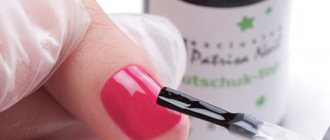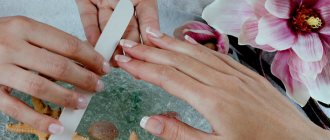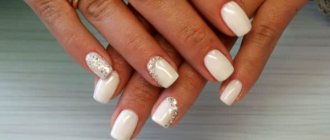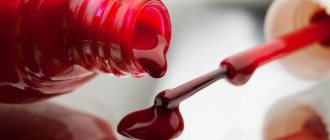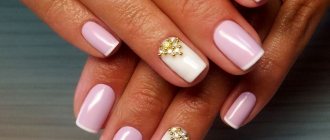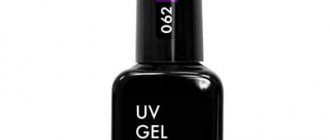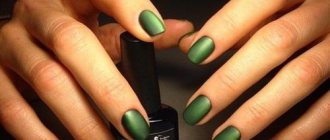Decorative nail decoration with gel is in great demand among girls. And this choice is easy to explain: re-application of the decorative coating will be required no earlier than after 2-3 weeks, the nails will look perfect all this time, they are unlikely to have chips and scratches, and their strength will increase significantly. Gel polish is a salvation for thin and brittle nails, which are so difficult to grow without special tricks. Plus, gel polish is beautiful. With it, your hands always look well-groomed and neat, and you don’t have to worry about their beauty “before going out.”
To create a gel polish manicure, different products are used. Experienced nail technicians can easily navigate the variety of varnishes, but it’s easy for beginners to make a mistake and buy something completely different from what they need for a home manicure. Let's try to figure out what a gel can be and what the differences are between different types.
Gel polish removal procedure
Let's consider the stage of removing shellac from one nail. Obviously, you need to work on each nail in the same way.
- Apply a cotton swab to the nail, previously soaked in gel polish remover. For this, it is best to use a cotton base, because it can protect the nail from any negative effects.
- On top of the nail with a sponge you need to wrap a piece of foil 10 by 10 centimeters.
- Wait 15 minutes.
- Remove the foil and sponge from the nail. Using an orange stick, tap a little and crush the gel polish.
- A small file designed for polishing nails will help get rid of the remaining shellac.
How to remove gel polish correctly, see the following video.
What does gel polish look like? Advantages and disadvantages of gel polishes
Gel polish cannot be distinguished from regular polish. It is applied in the usual way, but the composition can only be dried using a special ultraviolet lamp. Having tried gel polish once, fans of colored manicure remain faithful to it. There are a number of reasons for this:
- the composition forms a coating that protects the nail plate from mechanical damage;
- the color and integrity of the coating - provided the correct application technique is followed - is maintained for three weeks;
- gel polish does not require cutting off the natural plate, as happens when adding nails, and at the same time provides the same durability and aesthetics of a manicure.
At the same time, preparations for applying the composition and the process of wearing it have negative consequences for the condition of the nails. Let's list some of them:
In order for the coating to look neat, intensive treatment of the nail plates with a buff is required
Mechanical impact with an abrasive tool does not help strengthen them; gel polish is a dense composition that blocks the access of oxygen to the nail plates, which can lead to slower growth, brittleness and even deformation of the nails; staying under the protective coating of varnish for a long time causes the nails to stop producing a natural protective layer, so they require very careful treatment after the varnish is removed; potent compounds that are used during preparation for applying the composition weaken the nails; gel polish tends to stain nails.. The last of these negative consequences cannot be combated with the help of cleansing compounds
The tint will disappear only after the nail grows out
The last of these negative consequences cannot be combated with the help of cleansing compounds. The tint will disappear only after the nail grows out.
After weighing the advantages and disadvantages of wearing a gel coating, every lover of a beautiful manicure can independently decide which type of polish to choose.
Triphase gel polish. What is the difference between single-phase, two-phase and three-phase gel polish
All girls love a well-groomed manicure. This manicure gives the hands tenderness, neatness, femininity, and the owner herself - confidence in her irresistibility. The permanent coating industry appeared relatively recently, and almost immediately won women’s hearts. After all, now a beautiful manicure is not a dream, but a reality. There are several types of gel polishes for long-term coatings. Let's look into them and compare their application technologies.
Single-phase gel polish
The single-phase gel polish contains three formulas mixed together: the base (base), the main color and the protective layer (top or, in other words, finish). To work with single-phase gel polish you will need: 1. Primary color (actually, the gel polish itself) 2. UV or LED lamp.
application method
1. First you need to give your nails the desired shape, remove and push back the cuticle. 2. treat the nail with a soft buff, remove the glossy surface of the nail. 3. degrease the surface of the nail. 4. Apply the first layer of colored gel polish, carefully not touching the cuticle and periungual fold. 5. Dry your nails in a UV/LED lamp. 6. Apply a second layer of gel polish and dry it in the lamp.
advantages of single-phase gel polish:
1. time saving: the technology requires a primary color, which must be applied in two layers and use a UV/LED lamp (first layer and lamp, second layer and lamp).
2. saving money: instead of three products, you only need one and a UV/LED lamp. 3. Single-phase coating has a lower density compared to three-phase gel polish, which allows the nail plate to breathe and not dry out. Lack of consistency of single-phase gel polish
1. Limitations of design. The system does not require a topcoat, so there is no sticky layer. Accordingly, decorating a manicure with a design is very problematic. 2. Less durability. No matter how the manufacturers of fairly inexpensive single-phase gel polish claim that durability does not suffer in any way. This is wrong. The application technique consists only of the main color; the system does not provide a base and top for such a manicure. Which significantly reduces the durability of such a manicure. Additionally, if your nails are soft or too long, the gel polish may crack. A question immediately arises. Can I use a top coat? Can. There are already top coatings on sale specifically for single-phase gel polish. You can already buy them in the online store Byfashion.ru
Two-phase gel polish
Two-phase gel polish involves applying a base under the gel polish. It is better to choose a rubber adhesive base for good adhesion of the gel polish to the nail plate. You can use top coat and colored gel polish without a base. But applying the color of two-phase gel polish without a base is not advisable for the nail plate. Since the chemical elements of such gel polish have a detrimental effect on the condition of the nail. The method of application is worth listing: 1. Use a soft buff to file off the top (shiny) layer of the nail plate. 2. Degrease the nail plate with a lint-free cloth. It is advisable not to touch the nail with your fingers after degreasing. 3. Next, use an orange stick or pusher to push back the cuticle. 4. Apply a transparent base under the gel polish in a thin and even layer. This will allow the colored gel polish to lay down evenly. 5. Dry in a UV/LED lamp with a power of over 36 watts. 6. IMPORTANT! You need to remove the sticky layer from the set base. You need to clean it with a special tool - a cleaner, using lint-free napkins. It is recommended to use a cleaner from the same company as the gel polish. Otherwise, the gel polish on your nails may become cloudy. 7. Apply colored gel polish and dry again in the lamp. If the color is not bright, you can apply a second coat, but be sure to remove the sticky layer from the first paint job.
Three-phase gel polish
This system is universal and consists of three bottles:
- Base coat.
- Color coating.
- Fixing coating.
The function of the base coat can be compared to double-sided tape. It strengthens the nail plate and at the same time securely adheres the colored coating.
The function of the fixing coating is to fix the color and protect it from fading, thus ensuring long-lasting wear. In addition, it can be glossy or matte and even have a certain smell, which, after drying under the lamp, leaves a light aroma of fruit, coffee or chocolate on the nails. This coating is also sticky.
It is believed that this gel polish is great for applying some kind of sticker or slider to the surface of the nail. The advantage of this coating is also that the nails do not turn yellow in light areas for a long period of time.
Advantages of using three-phase varnish:
- Allows you to carry out the correct three-level manicure procedure;
- Suitable for all types of nails.
Minuses:
- you need to buy three different bottles for manicure;
- it is impossible to replace any of the stages of the procedure;
- There are difficulties with applying the coating.
How is gel polish different from regular polish?
Regular nail polish is a colored coating that:
- It does not stay on the nails for long without chipping: from 3 to 5 days.
- Nail polish takes a long time to dry in the air: it is not advisable to touch anything for at least half an hour after applying it.
- Washable with nail polish remover.
Every girl has used regular nail polish at least once in her life and has a good idea of what it is and how to apply it. The variety of varnishes is simply huge: you can find special medicinal varnishes, and varnishes with various effects, for example, craquelure, matte, sand, magnetic and others, as well as varnishes with additions in the form of sparkles, shimmer, and so on.
Gel polish is a cross between regular nail polish and gel for extensions, which is why it has such a name. The main goal that was set during its development was to combine in it all the best properties of both coatings: that is, durability and color. And this, of course, was achieved!
- Externally, a bottle of gel polish differs from regular polish in that it is not transparent. The color is indicated either by a sticker or paint on the bottle. This is done so that the gel polish does not lose its properties when exposed to sunlight.
- For the gel polish to dry, you need to hold it for 2-3 minutes in an ultraviolet lamp or 30 seconds - 1 minute in an LED lamp.
- Due to the properties obtained from the gel, the wear time of the gel polish coating increases to 3 weeks.
- The technique of applying gel polish requires additional nail preparation: degreasing the surface, removing the gloss with a buff, and the mandatory use of a base and top coat for gel polish. Additionally, liquid may be required to remove the sticky layer, if any.
- The presence of additional materials and a lamp for applying gel polish makes this procedure more expensive, so many people prefer to have it done in a salon or by a specialist at home.
- Removing gel polish from nails is also more difficult; regular gel polish is not enough. It must either be soaked with a special agent or removed mechanically using a hard file or cutters.
For whom is it better?
Extensions are suitable for girls who are not satisfied with the shape of the plate or if it is short in length; the specialist will do the work, taking into account the client’s wishes. On long nails you can draw a pattern or design of varying complexity. It looks interesting and gives the manicure originality. Rhinestones and bottles will hold up well, and various compositions can also be created with them.
Artificial nails are durable and rarely chip or crack. An ideal option would be for girls whose gel polish quickly chips off the nail for physiological reasons. The extensions are worn unchanged for up to 4-5 weeks, but it is better to make the correction at the right time so that problems do not arise.
Gel polish is suitable for any nails. It looks quite natural and is suitable for young girls and older women. If you apply a natural shade to the coating, you may not immediately notice its presence. Correction of this method is required only after 2-3 weeks. Some people like to wear extremely short lengths, in which case gel polish is the only option.
One of the most popular designs for medium length is French manicure or French manicure. In the nail service, this manicure is considered a classic and is in great demand.
The ability to do the procedure yourself at home. This is a big advantage compared to extensions. This allows you not only to save time and money and to be confident in the safety of the tools you use.
In general, these methods have almost the same technology. After analyzing the advantages and disadvantages of the methods, every girl will be able to choose exactly the manicure that is suitable for her nails.
What is extension gel
Nail gel is understood as a cosmetic product that is characterized by a rather complex chemical composition of polymers and pigments.
Moreover, such a structure is quite similar in characteristics and appearance to the natural human nail plate. The gel can be used for extensions using:
- Special forms. This version is perfect for those with a good shape of their nail bed. Also, owners of long and fairly strong marigolds can choose this variation.
- Tips. This variety, on the contrary, is best suited for the fair sex with short natural nails. In this case, an additional important layer is needed, which is used to improve the important adhesion of the real and artificial nails.
The main advantages of gel extensions:
- High-quality completion of all stages of work does not take a long time - from two to three hours;
- The high strength of gel nails will please any woman. At the same time, the undoubted bonuses in comparison with acrylic nails, for example, will be the higher strength and ductility of the gel layer;
- Affordable price;
- An important advantage of gel extensions will be the ability to quickly restore possible chips and detachments;
- A great opportunity to strengthen your own natural nails. It is when choosing such a modern material that many representatives of the fair sex have the opportunity to quickly and easily grow natural nails, even in cases where this was not possible before;
- The gel will be an excellent choice for people prone to allergies. Unlike acrylic, it is not able to emit a strong unpleasant odor and is not toxic.
Palette
Each manufacturing company offers a wide selection of colors. The assortment includes the following colors and their shades:
- red;
- green;
- blue;
- violet;
- white;
- black.
It will not be possible to list all the options available on the nail industry market, since there are countless shades. Taking into account the wishes of the most demanding consumers, companies offer various collections containing unusual tones.
The “Precious Stones” line is in particular demand. Like pearls, these gel polishes shimmer in the sun, creating an amazing and mesmerizing effect.
It is worth paying attention to the “Thermo” line. It is represented by almost all companies
The products can change shade depending on the ambient temperature.
The Cat's Eye series is also offered by most manufacturers. To achieve the desired effect you will need a magnet. In the palette you can find green, blue, purple, brown shades. Each girl will choose a suitable option for herself.
You can find interesting gel polishes in the line of any company. For example, the “Morocco” series, produced by the Korean company TNL. The coating shimmers on the nails with all the colors of the rainbow. The effect is similar to that obtained as a result of applying compositions from the “Precious Stones” collection.
Types of single-phase nail polishes
Single-phase nail polish comes in several types:
- Traditional enamel products. This is a colored coating in bright or pastel shades with a glossy sheen.
- Translucent. Used to give nails a natural and healthy look, they have subtle natural shades. Good for a plain manicure or a French manicure.
- Mother of pearl. There are juicy and light shades with a pearly shine.
- With shimmer. These are gel polishes of different colors with small or large glitter. The shimmer can be silver, golden, or the same shade as the flower bed itself.
- Neon. As a rule, these are bright shades that look like enamel in normal lighting. But under the neon lamp they begin to glow.
- Thermo. These products change depending on the temperature, so the shades are lighter at the tips of the nails. In the cold the color will also be different than in the warm.
Reinforcement technology
Single-phase gel nail extension technology is carried out using tips and forms. Tips are part of the resulting nails, which are made of synthetic material – plastic. The forms are a disposable product with a paper base, which is attached to the nails during extensions.
Each type of extension accessory requires its own specific pattern. In general, the application and use of single-phase gel in such cases is similar, but the resulting effect may differ. Nail extension using this method requires the use of one jar of gel, which will be used to apply all layers. When applying the base layer, keep in mind that the consistency of this product is liquid.
But you can see what thermal nail polishes look like in the photo.
How to apply to the mold correctly
When building up, the first thing to do is to substitute the shape. This is done in such a way that movement and wobbling of the plate is eliminated. That is why this version of the material is provided with special marks that will allow you to choose the most optimal length for all nails. The advantage of this type of extension is that after the procedure, the claws will look as natural as possible.
- Using a special brush, the gel is applied to the plate using trampling movements. After this, the composition is applied to the seam. The same layer is used to form the required length of the nail. Next, drying is carried out until complete polymerization (exposure time is usually indicated by the manufacturer). Make sure that the material does not spread onto the cuticle and sides of the rollers. But you can read here how horsepower nail polish is used and who it is suitable for.
- After the first layer has dried, apply the second, dry, and then file the nail with a file. The surface should be sanded with the softest possible abrasive - buff, and then get rid of dust with a stiff brush. You should also learn more about the most popular gel polish design for short nails.
- At the third stage, a thin application of the same product is carried out. Be sure to ensure that the ends are sealed. After final drying in the lamp, the cuticle is varnished.
Gel nails are not only beautiful, but also durable. A well-executed manicure allows you to have beautiful, well-groomed nails for up to four months. But you should understand that they need to be corrected periodically.
How to build on tips
This type of influence is no less simple than building up forms. An important aspect of this procedure is the correct selection of tips. The shape must completely match the shape of the nail.
The extension is carried out as follows:
- An antiseptic is applied;
- The surface of the nail is polished;
- Tips are glued (from half to 1/3 of the nail, no less);
- The length of the tips is adjusted (using a file);
- A transparent layer of gel is applied and then dried in a lamp until completely dry;
- A thicker layer is applied again and dried again, but until complete polymerization.
Strictly speaking, all actions are not very different from using forms. It is also necessary to adjust the length and shape, ensure that the ends are tightly sealed, and also prevent the composition from getting on the cuticle and nail folds.
Types of gels for tangible strengthening of nails
To significantly strengthen natural nails, biogels and conventional gels are used with a noticeable strengthening effect. Let's take a closer look at what the difference is between these modern variations.
In order to apply such a coating, you do not need to significantly file off the top layer of the nail. On average, this covering is worn for about three weeks. The main advantages of biogel include the following:
- The coating itself is highly elastic and looks absolutely natural and attractive;
- When removing the biogel, your own nail plate does not suffer. For this reason, it is so widely used in the process of necessary recovery after extensions, when nails can become thin.
- With the help of biogel you can grow your natural nails simply and quickly and without any problems.
Gels with a strengthening effect can be one-, two- and three-phase. Their main difference is the number of application steps required. It is clear that a single-phase product is a combination of a base, main, and also an important topcoat. In the case of a three-phase product, the components must be applied separately in full accordance with the technology.
Review of manufacturing companies
On the modern market you can easily purchase gel polishes produced by companies such as:
- Irisk;
- TNL;
- Masura;
- Patrisa Nail;
- Khan;
- Bluesky.
The list goes on for a long time. Bluesky products are in unusually high demand. This option is supported by its reasonable cost and wide selection of shades offered.
The Korean brand TNL Professional is also quite popular. The optimal consistency of the product allows you to distribute it evenly and accurately over the entire surface of the nail. Consumers have the opportunity to choose from a variety of tones and colors. Representatives of the fair half of humanity often choose varnishes from the “Cat's Eye”, “Thermo”, “Morocco”, and “Mosaic” series.
Masura offers a wide range of single-phase and three-phase varnishes. You can use products produced under this brand at home and in the salon. The advantages of this manufacturer include the fact that the company produces formulations in small bottles. This is very convenient if you create a manicure at home.
Giorgio Capachini gel polishes are sold in 6 ml bottles. The consumption of the product is quite economical. The composition is enough to do a manicure 20-25 times. This is more than enough for home use. The varnish will not have time to get tired or dry out. To completely dry the layer, 1-3 minutes are usually enough, depending on the power of the device. You can remove the coating quickly and easily using a special liquid.
Irisk Professional gel polishes are distinguished by their affordable cost and high quality. The creator assures that they can last up to three weeks without cracks or chips. The company offers a wide range of colors.
Three-phase
The three-phase system differs from the two-phase system by the use of a final gel, which is necessary to remove the sticky layer. This gel speeds up the work process and performs a protective function against external aggressive factors.
In general, the sequence of working with three-phase gel polishes looks like this:
- We perform a manicure (shape the nails, remove and push back the cuticle), degrease the surface of the nails.
- Apply the base and dry it in an ultraviolet or LED lamp
- Apply the first layer of colored gel polish and dry it in a lamp. If necessary, repeat the application of colored layers, and do not forget to dry each of them well.
- Remove the sticky layer.
- Apply the top coat (finishing coat) and dry it again in the lamp.
The clear advantage of three-phase coating is its resistance to external influences and durability. You will need to update your manicure much less often. This effect is achieved by using a base and finish. They are the ones who hold together all the components of the coating with the nail plate as tightly as possible.
In addition to its durability, this coating also provides an attractive glossy sheen thanks to the top layer.
During the entire period of wear (and it lasts on average 3 weeks, and sometimes longer), the coating does not deform, and the original color does not fade.
And of course, all fashionistas will be pleased with the fact that when using multiphase systems, you can safely use all kinds of decorative elements in nail design; they will stick well, since they will be tightly sealed in the layers of coating.
The disadvantages of three-phase gel polishes include the financial side of the issue, since you will need to invest more money to purchase them. At one time you need to buy 3 bottles for coating instead of one.
Another factor that is also worth considering is the duration of the manicure. In the case of three-phase gels, the work will definitely take longer.
It is also worth noting that only a professional master can cope with the manicure procedure using three-phase gel polishes, since its application is a very complex procedure that requires certain experience, knowledge and technique. If you are choosing gel polish for independent home use, it is best for these purposes to opt for single-phase products.
Please note that no matter which of the listed products you choose, you must pay attention to the quality of the material. And the easiest way to distinguish this is by smell - high-quality coatings do not have any sharp, unpleasant aroma. If there is no pungent odor, it means that the composition does not contain dangerous components that adversely affect human health.
After studying the information on the differences and features of single-phase and three-phase gel polishes, you can easily make a decision and choose one of the products.
What is three-phase current
This is a system that combines three electrical circuits with currents that differ in phase by 1/3 of a period. Moreover, their own EMFs coincide in frequency and amplitude and have the same phase shift. For such a structure, the phase and line voltages are respectively 220 V and 380 V. The frequency of periodic oscillations is 50 hertz (Hz).
If you connect current sinusoidal signals from a three-phase network to an oscilloscope, you will see that they pass through their maximum points in a regular phase sequence.
The general formula for AC power is:
Where:
- P – power, (W);
- I – current, (A);
- U – voltage, (V);
- cosϕ – power factor.
The cosϕ value should tend to unity. The average power factor lies in the range of 0.7-0.8. The higher it is, the greater the efficiency of the installation.
In the case of 3-phase networks, the power will depend on the connection diagram of the source and load.
What does three-phase gel polish mean? Single-phase gel polish
Covering nails with gel polish is very popular. But many representatives of the fair sex refuse this type of manicure due to some difficulty in performing it, and also because such a procedure takes a lot of time. But now that there is a special single-phase gel polish on sale, you can safely forget about these shortcomings.
What it is
As a rule, a manicure using gel polish occurs in three stages, but using a single-phase coating, you can perform a manicure much easier and faster. This means that single-phase gel polish combines the functions of a base, a fixer and the color coating itself. Now you just need to apply one or maximum two layers of this product on your nails and the manicure is considered complete. In addition, this nail coating is safer.
Single-phase gel polish has a unique composition and formula. It combines several components that are included in a regular base for gel polish, its fixer, and also a color pigment. That is why its use allows you to replace three usual means for creating a manicure using gel polish or shellac.
By performing a manicure using this particular coating, you can not only get a chic nail design, but also significantly reduce the time it takes to complete it, as well as save on the procedure itself.
But besides ease of use, this tool has other obvious advantages.
Advantages
If we talk about the advantages of this new product for performing gel manicure, there are quite a lot of them. The most basic ones are the following:
- Speeding up manicure and simplifying it. Now, instead of three jars with the necessary products, you should use only one.
- This coating will lie on the surface of the nails in a thin layer, which means that the nails will be able to breathe. In addition, a manicure made using such a single-phase varnish will look more natural.
- You can save a lot. The cost of single-phase gel polish is several times less than the total cost of the three conventional products that it replaces.
- This nail coating, despite the thinner layer, can stay on the nails longer than the usual gel polish. On average, the durability of such a manicure can last up to 4 weeks. But it will be correct to remove single-phase gel polish from the surface of the nail bed after 15 days, since the nails will grow during this time, and their grown edge will not make the best impression.
- This product can be dried not only in an ultraviolet lamp, but also in an LED lamp. But this method of polymerization is not suitable for all conventional gel polishes.
- You can cover not only your natural nails with this product, but also your extended ones.
- And another undeniable advantage of this product is the saving of work space during manicure. There is no need to place several vials on the table; one will replace them all. This is especially true for manicurists, whose work surface is always heavily cluttered.
- All varieties of such single-phase products sold today can be used in combination with each other. For example, you can paint your nail with one color and create various patterns on its surface with any other color.
What are one-, two- and three-phase gels
The gel nail extension procedure involves applying 3 layers:
- Basic, creating the basis for subsequent layers, correcting unevenness of the nail plate;
- Modeling, or sculptural, determining the strength, thickness and shape of the extended material;
- The final (finishing) one, responsible for protecting the manicure from aggressive factors and its appearance.
“Phasity” refers to the number of layers (phases) the polymer creates. This means that a single-phase nail gel forms all 3 layers, and a three-phase system is represented by 3 different products, each of which is responsible for a separate layer.
What is single-phase gel for nail extensions
A single-phase product means using the same product to apply all 3 layers. It is presented as a 3-in-1 mixture, which carries the characteristics of each individual polymer: base, sculpture and finishing.
The mass is not applied in a single layer; with single-phase nail extensions, the principle of layer-by-layer application is also observed.
Two-phase
This nail modeling system is represented by 2 means. One of them is applied as a base layer, the other forms a sculptural and finishing layer. Each of the 3 layers is dried separately.
Three-phase
For a three-phase manicure, a system of 3 polymers of different composition and consistency is used:
- Flowable base gel with priming properties;
- Viscous sculptural substance;
- The most durable gloss after polymerization.
The modeling gel can be camouflage (imitating a natural nail plate), colorless, sculptural or pigmented.
Thanks to this, three-phase nail extensions provide a large number of designs (French with camouflage, volumetric figures, stickers). Single- and two-phase gels lack this advantage due to the fact that they do not provide a separate container with a sculptural component.
Single-phase gel nail extension technology.
Before starting the procedure, it is necessary to thoroughly clean the hands of the master and the client using an antiseptic. Then you need to push back the cuticle with a special stick, carefully file the nails under the holes for tips, and carefully polish the nail plates to completely remove the oily top layer. These preparatory works are extremely important, since in the process of further work they will help you prevent the material from peeling off, and therefore create more neat and natural gel nails.
The selection of tips must be done individually for each nail, since a lot depends on the correct selection of tips. The tips are glued to the free edge of the nail using special nail glue. Then, using a special tip cutter, the master achieves the required length of the tips, after which they are given the desired shape using a nail file.
After this, it is necessary to clean the tip seam as carefully as possible, after which the nail is filed until the shine is completely removed. Then the nail must be smeared with a special substance - a primer, which must be allowed to evaporate. After the primer has completely evaporated, the first layer of single-phase gel is applied to the surface of the nail using a special brush. Then the gel-treated nail must be placed under an ultraviolet lamp for 1 minute.
After this (without removing the sticky top layer), a second layer of gel is applied to the nail, which must be laid more evenly and densely than the previous one. After applying the second layer of single-phase gel, the nails must be placed under an ultraviolet lamp again, only this time not for 1, but for 2 minutes. If the second layer of gel does not turn out perfectly smooth, do not be upset. It is necessary to carefully remove the sticky layer using a special product, then file the nail with a file, and once again carefully cover it with gel.
The final stage is filing the nails with a soft file and applying special cuticle oil to them. This concludes the single-phase gel nail extension technology, and your gel nails are ready for further processing. You can varnish them, apply a design - in short, do whatever you have enough imagination for.
It is worth understanding that the quality of the final result directly depends not only on the hands of the master, but also on the quality of the material, regardless of whether you chose a single-phase gel or a three-phase one. Therefore, the choice of a single-phase gel must be approached extremely carefully. This is no wonder, because the range of products offered to customers is so large that quite often it is not easy to make a choice. Therefore, let's try to figure out this issue.
A high-quality gel should have a fairly soft consistency in order to fit well on the nails. Also, the gel should not leave a brush mark, and should be plastic, so that it can be used to give your nails the desired shape as easily as possible. However, in addition to this, the choice of gel often depends on the preferences of the master, since most often different masters like different gels, and you can only decide which gel is best for you through experience.
Although we know almost everything about all modern nail extension gels, we cannot tell you exactly which gel you will be most comfortable working with. However, we will give you some recommendations that will help you make the right choice of single-phase gel for nail extensions. So, to begin with, you should carefully read the information about all manufacturers of extension gel, and look for reviews about their products on the Internet and in magazines. In addition, you can interview practicing hair extension specialists, since their personal experience will be extremely valuable to you.
In general, if you decide to find the best nail extension gel for you, then you should decide what exactly you expect from this material, and what goals you plan to achieve with it. Just think about whether you plan to use this gel for home or professional use, whether you are interested in complex designs, or whether you prefer nail extensions with French gel, or whether you simply need to increase the length of your nails. Having decided on these most important questions and found detailed information, choosing the ideal single-phase gel for nail extensions will not be difficult. Well, if you are completely confused by the variety of these products, then contact us, and we will try to help you in this matter.
How to apply single-phase gel at home
The system is applicable for modeling nails on forms or tips.
How to extend nails with single-phase gel using a form
- Treat the cuticle with special oil, remove it with a trimmer or push it back with a pusher.
- File the free edge of the nail, round off any existing irregularities so that they do not interfere with the installation of the form.
- Use a buff to create roughness on the glossy layer of the nail, moving it in the longitudinal direction from the pterygium to the free edge.
- Place the extension form under the free edge of the nail so that it fits snugly against the nail plate and serves as an extension of it.
- Degrease the nail, treat it with a primer to enhance the adhesive properties of the first layer of polymer.
- Apply a thin layer of single-phase gel using a brush along the entire nail plate, retreating 0.5-0.75 mm from the cuticle.
- Place it in the lamp. Wait for it to polymerize for 60 seconds.
- Using a modeling brush, apply a drop of gel to the form, create an artificial free edge, and spread evenly over the previous layer.
- Place in the lamp for 2-3 minutes.
- Remove the sticky layer, give the nail the desired length, align the side edges, cut off excess polymer. Remove sawdust with a brush.
- Degrease before applying the topcoat.
- Apply a final thin layer over the entire surface of the resulting nail.
- Place in the lamp for 60 seconds.
- Remove the sticky layer from the finished work.
Extension on tips
- Treat the cuticle with special oil, remove it with a trimmer or push it back with a pusher.
- Choose a tip that suits your shape and try it on. Make sure it follows the curve of the nail and is completely adjacent to it.
- File the free edge of the nail so that it follows the shape of the tip's hole.
- Treat the glossy layer of the nail with a buff, moving it in the longitudinal direction.
- Distribute a drop of special glue on the inside of the tip hole. Place it just below the mid-length of your natural nail. Press it onto the nail plate and wait until it sticks.
- Using special cutters, cut the material to the required length. File down the free edge of the tip.
- Using a buff or a soft file, process the seam of the tip and its surface to create roughness.
- Apply degreaser to the work surface, then primer.
- Apply a thin layer of single-phase polymer over the natural part of the nail. Place in the lamp for 60 seconds.
- Apply the 2nd layer of gel to the natural nail and tips along the entire length. Place in the lamp for 60 seconds.
- Remove the sticky layer.
- If the gel lays down unevenly, after removing the sticky layer, cut off the excess polymer. Apply the 3rd layer of gel, place the nail in the lamp for 60 seconds. Remove the final sticky layer.
Features of single-phase coating
The new long-lasting varnishes are perfect for use by professionals and at home. In this case, applying single-phase shellac is quite easy, which means a significant saving of time.
Manufacturers guarantee that nails will remain beautiful for more than a week; according to girls’ reviews, at least 10 days. Beautiful palettes are produced by the famous companies Bluesky, Masura and Patrisa Nail.
You can understand what it is, see the advantages of using it and what advantages the use of single-phase shellac provides from the reviews of craftsmen who work with it:
- The special formula does not require a base coat or sealing, so there is no need to purchase additional bottles from different companies. This significantly saves the master’s budget.
- There is no need to purchase expensive additional nail treatment products and tools, which means a reduction in manicure time.
- Some single-phase shellacs, such as Masura and Patrisa Nail, do not have a sticky layer. Immediately after drying, you can do your usual household chores.
- No need to apply multiple layers to enhance color intensity. Bluesky's dense single-phase shellac looks great after one coat.
- Maximum ease of use, which makes it possible to decorate nails at home.
Who is suitable for single-phase gel?
Single-phase gels are inferior to three-phase professional systems, but are suitable for home extensions for those who want to have a well-groomed manicure without overpaying for the product. Single-phase products are less troublesome and, when applied correctly, are no less durable than three-component polymers.
Did you like the article? Subscribe to our VKontakte . Don't forget to tell your friends about the article using the social network buttons. Thank you!
Source of the article: https://nails-info.ru/manikyur/materialy/kak-polzovatsya-odnofaznym-gelem-dlya-narashhivaniya-nogtej.html
Secrets of use
There are several secrets and subtleties in using polygels. By following them, you will certainly make it easier to work with the material and achieve excellent results in nail extensions and repairs. In general, extensions are not a simple process, since the master requires accuracy, attentiveness and dexterity. If desired, polygel is used not only in salons, but also at home, but the rules for use are strictly followed.
To get quality nail extensions with polygel, you will need:
- Carry out a manicure according to the standard scheme - classic, hardware. At the final stage of manicure, remove the pterygium.
- Treat the surface of the nail with degreasers.
- Apply a thin layer of base as this will act as an adhesive layer. Dry it and only after this stage lay out the acrylic.
- Wet the brush with clinser (alcohol) and wet it with a napkin. Squeeze the polygel onto the plate and distribute it according to the desired shape.
- Pull the remaining composition to the tip and remove with a brush. Knead the composition, stretch it as long as possible until it is fixed in the lamp.
What is good about single-phase gel?
Beginners learning the basics of extensions are often interested in how a single-phase gel works. Some people think that it is of lower quality than two or three-phase material. This is not true, it’s just that a single-phase gel makes the job easier.
The consistency of this product is quite liquid, which makes it easier to model the shape of an artificial nail. In addition, this product provides strong adhesion to the natural plate, which guarantees long-term wearing of extended nails without peeling off the material.
It is believed that single-phase gel extensions are more gentle and are indicated even for weakened, damaged and brittle nails. By the way, it also does not cause allergies and can be used for extensions even by pregnant women.
How does a generator work?
The device works by converting rotational energy into electrical energy. The electric machine, using the rotation of the MP, generates electric current. At the moment when the wire winding (coil) rotates in the MF, the magnetic field lines penetrate the turns of the winding.
Attention! As a result of this process, electrons move towards the positive pole of the magnet. In this case, the current moves, on the contrary, towards the negative magnetic pole
It doesn’t matter what rotates under mechanical action, a winding or a magnetic field, the current will flow as long as the rotation is performed. Generators producing three-phase voltage may have:
Generators producing three-phase voltage may have:
- fixed magnets and a movable (rotating) armature;
- a stationary stator and magnetic poles that rotate.
In devices of the first design, there is a need to draw a large current at a high voltage. To do this, you have to use brushes (contacts sliding along slip rings).
The second generator structure is simpler and more in demand. Here the rotor is a moving element and consists of magnetic poles. The stator is a stationary part, assembled from a package of iron sheets insulated with each other and inserted into the grooves of the stator winding.
Information. The rotor has a body made of solid iron and has magnetic poles in the form of tips. Tips are assembled from separate sheets. Their shape is selected so that the generated current is close to a sinusoid in shape.
Pole cores have field coils. The coils are supplied with direct current. The feed is carried out through graphite brushes to the contact rings located on the shaft.
In the diagrams, a 3-phase generator is drawn as three windings, the angle between which is 1200.
There are several ways to excite generators, namely:
- independent - using a battery;
- from the exciter - using an additional generator mounted on one shaft;
- due to self-excitation - its own rectified current.
This also includes magnetic excitation supplied from permanent magnets.
Three-phase nail gels Led and UV
Formula Profi
- Odorless, with a neutral pH level;
- Polymerization time in a UV lamp is 90 seconds, in a LED lamp – 60 seconds;
- Includes base, clear builder gel and topcoat;
- Volume 10 ml;
- Price from 600 rub.
All season
- Modeling tinting gel, with glitter or hologram effect;
- Long polymerization time;
- High wear resistance;
- Volume 28 ml;
- The price of the construction gel is more than 1000 rubles.
IBD
- The base coat is acid-free, self-leveling, odorless, volume 14 ml;
- Sculpting gel is transparent, odorless, volume 14 ml;
- Polymerizes only in UV rays for 30 seconds;
- The cost of a three-phase line is more than 2000 rubles.
Runeil three-phase
- Camouflage or colored firming sculpting gel;
- Optimal ratio between price and quality;
- Self-leveling, medium viscosity;
- Polymerizes only in UV rays;
- Colored gels mix well;
- The volume of camouflage agent is 15 ml, color 7.5 ml;
- Price from 200 rub. for colored, from 350 rub. at the camouflage one.
Severina
- Three-phase system with camouflage sculpting gel;
- Consistency of medium-high viscosity;
- Allows air to pass through and does not overload the nail;
- Polymerizes in a UV lamp;
- Volume 15 ml;
- Price from 700 rub.
1-phase, 2-phase or 3-phase gel polishes?
Nowadays, you probably won’t surprise anyone with the word “gel polish,” since these products have become so popular that most women simply cannot imagine themselves without them. Indeed, they have a number of advantages that ordinary varnishes cannot compare to.
But you will probably be interested in learning about their types, features and application techniques, and also choosing the most optimal one for yourself, especially if you do a manicure at home.
Gel polishes are divided into three main groups - single-phase, two-phase and three-phase. Let's start with the last one.
Three-phase gel polishes
This is perhaps the most common and the only type that has remained since the appearance of these miracle coatings. The application technique consists of three products - base, color coating and top (finish). The base is designed to smooth the nail plate and create a special film that improves the adhesion of all layers. After we have dried the base in a UV lamp, we apply a colored coating behind it and dry it again. Here it is better to overexpose the nails under the rays than to underexpose them, since then “waves” may appear or the finishing coat will deform the previous layer. The top is also dried, and then the sticky layer is removed using a special product. That's all! It is three-phase varnishes that are considered professional and the most resistant to external factors. The most famous manufacturers are: Shellac, KODI, OPI, Jessica, Naomi, Gelish, etc.
Advantages:
- Creates a more reliable nail shield
- Lasts at least 14 days
- Not afraid of scratches and does not chip
- These gel polishes are the most affordable on sale and, as a rule, have a rich palette
Flaws:
- Labor intensity
- You need to have experience working with them
- Expensive procedure
Two-phase gel polishes
2-phase gel-based nail coatings are probably the rarest and not very popular. As you already understand, the system consists of two means. As a rule, this is a color coating and a fixer. It is even rarer to find a colored coating and only a base. Their advantage is that they are less labor intensive than 3-phase ones, but they also have a little worse wear and tear. The only most famous and well-proven one is VinyLux from CND, which lasts 7 days. Although it should be more classified as ordinary varnish, since it does not require a UV lamp, and the composition is far from related to gel varnish.
Single-phase gel: distinctive features
The difference between a single-phase gel and a two-phase and three-phase one is that all 3 polymer components are in a common container. The contents of the jar contain all the necessary coating functions: adhesive, modeling, protective. This means that with the help of one substance the adhesion of the polymer to the surface, strength, glossy shine and resistance to chipping are created.
Advantages of single-phase gels
- Due to its liquid consistency, the polymer is easier to distribute over the nail plate. Thicker two- and three-phase gels require more painstaking application and careful leveling.
- 3-in-1 products are cheaper than multi-component gel nail extension systems.
- Better tolerated by people with sensitive skin.
- The total thickness of the single-phase acrylic system is smaller, which reduces the load on the natural nail.
Minuses
- The wearing period of a single-phase manicure is shorter than that of two- and three-phase manicures due to the absence of a separate glossy layer.
- A low-viscosity polymer creates difficulties for novice artists: it flows onto the cuticle, under the side ridges, and spreads when forming the apex.
- It is impossible to create designs that use camouflage, colored gel, three-dimensional figures, or stickers.
Can a three-phase gel be used as a single-phase one?
The sculpting gel included in the three-phase nail extension system cannot be used as a single-phase product. It performs only a modeling function and requires an adhesive substrate and finishing coating.
But a single-phase product can be included in a three-phase application system as a 2nd layer, especially if the single-phase gel is from the same company as the base and glossy ones.
